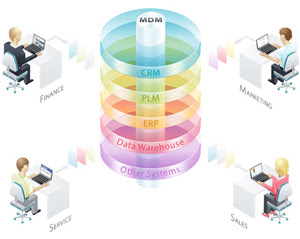A Step-By-Step Guide to Successful Customer Master Data Management Implementation
A lot of businesses struggle to make sure that their customer data is easy to find, updated, correct and shared just with the ones that actually need it. Maximum time of an analyst is consumed just on finding and preparing data, simultaneously find time to having avoidable data at hand makes it more difficult to locate the data that you do need. Luckily, these issues can be tackled through executing customer master data management solution.
Master data management solution builds a common definition and a unified view of the customer through centralizing the data and generating governance, data compliance and data security. Provided the volume of data and several systems which might be involved the customer mdm projects can be overwhelming. Let’s take a look at the five steps to customer master data management success.
Explore the Step-By-Step Guide to Successful Customer Master Data Management Implementation:
Step #1 Find your Customer Data and Those who have Access to It: Firstly, you need to determine where exactly your entire customer data is located. Understand the systems that actively build or update customer data compared to the systems that are passively making use of the data or reporting from it.
Step #2 Define Your Target Customer: What is the total number of customers you have? This is a basic question, but finding an accurate answer is tough if you don’t know who your potential customers actually are. To know who your target customer really is, you must understand how each department of your company views your customers. The shipping department might count each shipping address as a different customer, but a few might have multiple addresses or different customers might share the similar address. No matter what the case is, you should understand your company’s definition of a potential customer. You must find out the data attributes that is going to be common to every customer. Building a customer’s defining data points is the beginning of building a customer mdm model. Well-implemented data models define who your potential customers are that can be used in all the lines of business. They also build the outline for how exactly your customer’s data will be categorized, so that different features might be searched as per the needs.
Step #3 Assure Data Accuracy and Remove Duplicate Data: Once you have a customer master data management model, you must make sure that your data is correct and there is no duplicate data. If you have customer data in multiple systems then, possibilities are good that your company might have duplicate customers with variance in the information. You must get inaccuracies right and build a process to remove duplicate data as you begin with the integration process.
Step #4 Make a Data Governance Plan: Data governance will assist you control your customer mdm model, allowing you to keep your data set absolutely clean and correct. Good data governance ensures that your data is reliable and it gives responsibility as you aim to keep it updated and control your accessibility to the data.
Step #5 Execute Customer MDM: If your data is clean and you have a customer mdm model and data governance program in place then, you can start with the customer mdm implementation process.
The primary objective of customer master data management is to build a single place for all your customer data basically, a single data source which you can make use of to improve your business decisions.





Comments
Post a Comment